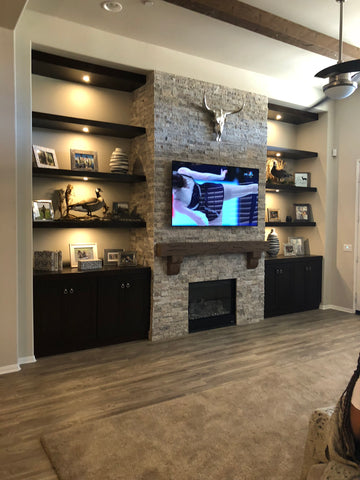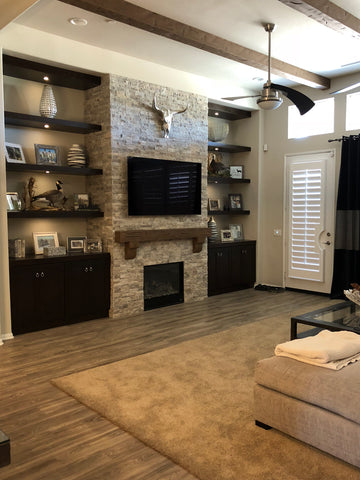
SHOP THIS LOOK HERE
1. Space: One of the most important elements of interior design is space, Space acts as a foundation or canvas on which the entire decorating plan is built upon. A space that is essentially filled with furniture/décor items is a Positive Space and a space that is empty is a Negative Space. A balance has to be maintained between both positive and negative spaces, skimping on the furniture/décor items can affect the overall balance of the space.


A decorating trick I use to ensure the element of balance has been achieved in space is taking a photo of my "seemingly" finished project. the photos expose the holes and or imbalances in my design
scheme.
for example here is a space I thought I had finished, I took a photo and low and behold ... do you see the imbalance? the photo gives me a panoramic view of the space, similar to looking at a page in a magazine.
Now, look at a photo on the right, after I corrected the imbalances revealed in the first photo.
wala! perfection! try this trick on your next decorating project and you'll get picture-perfect results!

SHOP THIS LOOK HERE
2. Line: Lines give birth to forms and shapes and are responsible for establishing a sense of harmony, contrast, and unity (3 of the 7 principles) in a living space. They define shapes and acts as visual guides of an interior space.

SHOP THIS LOOK HERE
3. Forms: Forms mean shapes in general. Forms can be created by combining two or more shapes and can be complemented with the help of other elements like texture, patterns, and colors. A well-defined form establishes harmony and additional forms add balance to the space.

SHOP THIS LOOK HERE
4. Light: Light is one of the most obvious elements of interior design. Either natural or man-made, without light other elements namely color, texture and pattern have no significance at all. Light sets in the mood and ambiance into a living space and highlights every other element including space, line, and forms.

SHOP THIS LOOK HERE
5. Color: Colors don’t need any special introduction. Colors establish an aesthetic connection between objects and set the mood. Colors must be chosen based on the psychology and the mindset of the dweller. For example, red is an excellent choice for a dining room as it encourages appetite and green for a bedroom as it is the color of tranquility and health.

SHOP THIS LOOK HERE
6. Texture: Texture mainly deals with surfaces and determines how a typical surface looks and feels. Texture adds depth and interest into a living space and defines the feel/appearance and consistency of a surface.

SHOP THIS LOOK HERE
7. Pattern: Patterns add interest and life to interior design and work along with colors. Patterns tell a story of their own and add the elements of continuity and smooth transition in a living space. some of the most common ways the pros inject patterns in a space on accent wall paints, pillow covers, and other decorative surfaces.

SHOP THIS LOOK HERE
These tips will get you started in the right direction to tackle your new decorating project and will make your space the envy of everyone who visits. With a little planning and testing, you can create a beautiful living space that works for you instead of against you. Happy Decorating!

Leave a comment